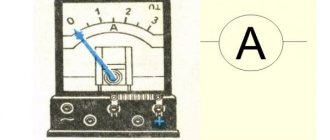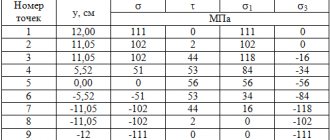Light-emitting diodes are characterized by a number of operational parameters:
- Rated (operating) current – In;
- voltage drop at rated current – Un;
- maximum power dissipation – Pmax;
- maximum permissible reverse voltage – Urev.
The most important of the listed parameters is operating current .
When the rated operating current flows through the LED, the rated luminous flux, operating voltage and rated power dissipation are set automatically. In order to set the LED operating mode, it is enough to set the rated current of the LED.
In theory, LEDs need to be connected to constant current sources. However, in practice, LEDs are connected to constant voltage sources: batteries, transformers with rectifiers or electronic voltage converters (drivers).
To set the operating mode of the LED, the simplest solution is used - a current-limiting resistor is connected in series with the LED. They are also called damping or ballast resistors.
Let's look at how to calculate the resistor resistance for an LED.
Calculation of LED resistor (using formulas)
When calculating, two quantities are calculated:
- Resistance (value) of the resistor;
- power dissipated by it P.
The voltage sources powering the LEDs have different output voltages. In order to select a resistor for an LED, you need to know the source voltage (Uist), the operating voltage drop across the diode and its rated current. The formula for calculation is as follows:
R = (Uist - Un) / In
When we subtract the nominal voltage drop across the LED from the source voltage, we get the voltage drop across the resistor. Dividing the resulting value by the current, according to Ohm's law, we obtain the value of the current-limiting resistor. We substitute the voltage expressed in volts, the current in amperes and get the nominal value expressed in ohms.
The electrical power dissipated by the damping resistance is calculated using the following formula:
P = (In)2 ⋅ R
Based on the obtained value, the power of the ballast resistor is selected. For reliable operation of the device, it must be higher than the calculated value. Let's look at an example of a calculation.
Example of calculating a resistor for a 12 V LED
Let's calculate the resistance for an LED powered by a 12V DC voltage source.
Let's say we have at our disposal a popular super-bright SMD 2835 (2.8mm x 3.5mm) with an operating current of 150mA and a voltage drop of 3.2V. SMD 2835 has an electrical power of 0.5 watts. Let's substitute the original values into the formula.
R = (12 - 3.2) / 0.15 ≈ 60
We find that a quenching resistor with a resistance of 60 Ohms is suitable. The closest value from the standard E24 series is 62 ohms. Thus, for the LED we have chosen, we can use a ballast with a resistance of 62 Ohms.
Now let's calculate the power dissipation across the resistance.
P = (0.15)2 ⋅ 62 ≈ 1.4
Almost one and a half watts of electrical power will be dissipated at the resistance we have chosen. This means that for our purposes we can use a resistor with a maximum permissible power dissipation of 2W.
All that remains is to buy a resistor with a suitable value. If you have old boards from which parts can be desoldered, then you can select a resistor based on the color marking. Use the form below.
On a note! In the example above, the current limiting resistor dissipates almost three times as much energy as the LED. This means that taking into account the luminous efficiency of the LED, the efficiency of our design is less than 25%.
To reduce energy losses, it is better to use a source with a lower voltage. For example, you can use an AC/AC 12/5 volt DC/DC converter for power supply. Even taking into account the efficiency of the converter, the losses will be significantly less.
LED voltage table depending on color
LED operating voltages are different. They depend on the materials of the semiconductor pn junction and are related to the wavelength of light emission, i.e. shade of glow color.
A table of nominal modes of different shades of color for calculating the damping resistance is given below.
| Glow color | Forward voltage, V |
| Shades of white | 3–3,7 |
| Red | 1,6-2,03 |
| Orange | 2,03-2,1 |
| Yellow | 2,1-2,2 |
| Green | 2,2-3,5 |
| Blue | 2,5-3,7 |
| Violet | 2,8-4,04 |
| Infrared | No more than 1.9 |
| UV | 3,1-4,4 |
The table shows that at 3 volts you can turn on emitters of all types of light , except for devices with a white tint, partially violet and all ultraviolet. This is due to the fact that some part of the power supply voltage needs to be “used up” to limit the current through the crystal.
With power sources of 5, 9 or 12 V, you can power single diodes or their sequential chains of 3 and 5-6 pieces.
Daisy chains reduce the reliability of the devices in which they are used by approximately the same number of LEDs. And parallel connection increases reliability in the same proportion: 2 chains - 2 times, 3 - 3 times, etc.
But the duration of their operation, unprecedented for light sources, from 30-50 to 130-150 thousand hours, justifies the drop in reliability, because The service life of the device depends on it. Even 30-50 thousand hours of work, 5 hours a day - 4 hours in the evening and 1 in the morning every day - is 16-27 years of work . During this time, most lamps will become obsolete and will be disposed of. Therefore, serial connection is widely used by all LED device manufacturers.
Parallel connection
Quite often it is necessary to connect several diodes to one source. Theoretically, to power several parallel-connected LEDs, one current-limiting resistor can be used. In this case, the formulas will look like this:
R = (Uist - Un) / (n ⋅ In)
P = (n ⋅ Iн)2 ⋅ R
Where n is the number of parallel-connected LEDs.
Why can't you use one resistor for several parallel diodes?
Even in “Chinese” products, manufacturers install a separate current-limiting resistor for each LED. The fact is that in the case of a common ballast for several LEDs, the probability of failure of light-emitting diodes increases many times over.
If one of the semiconductors breaks, its current will be redistributed through the remaining LEDs. The power dissipated on them will increase and they will begin to heat up intensely. Due to overheating, the next diode will fail and the process will then take on an avalanche-like character.
Advice. If for some reason you need to make do with one damping resistor, increase its value by 20-25%. This will ensure greater reliability of the design.
Example of correct resistor connection
How to properly connect an LED to the on-board network.
For the LED to work properly, it is necessary to limit the current flowing through it. To do this, the LED is connected to the on-board network in series with a current-limiting resistor. The need to limit the current is justified by the dependence of the service life of the LED on the passing current; the higher it is, the shorter the service life. But it should be noted that this dependence is nonlinear and if a certain recommended threshold is exceeded (see Datasheet for your model), the diode fails.
The figure shows several options for turning on LEDs with resistors and also indicates which of the inclusions are optimal, which are correct but less optimal in terms of energy consumption, and which are incorrect and will lead to a significant reduction in the service life of the LEDs. We have decided on the switching circuit option, now we have to figure out what resistor is needed for the LED.
Online calculator: “Calculation of a resistor for an LED.”
The formula for calculating the resistor is as follows: R= (Upit – (Upr.sv* N))/I
Where: Upit is the voltage of the power supply Uptr.sv is the direct voltage on the LED, N is the number of LEDs, I is the current passing through the LED. The question naturally arises: where to get this data? For those who decided to give up because... does not know anything about the name and origin of the mined diodes, - I’ll say, don’t rush, a universal solution to your question will be given below.
Let's take as an example a Datasheet for a 3 mm LED from kingbright. The figure below shows a screenshot indicating the characteristics of the LED with a current passing through it of 2 mA at a temperature of 25C. Of all the presented characteristics, we are only interested in Forward Voltage - the forward voltage on the LED.
- power
- pulse current
- direct direct current (DC Forward Current), it is this value that interests us; in this case, the passage of current above 25 milliamps (at a temperature of 25 degrees Celsius) must not be allowed.
The last figure illustrates the dependence of the characteristics on the conditions of use:
- dependence of forward voltage on passing current
- dependence of the intensity of the light flux on the passing current
- dependence of passing current on temperature
- dependence of luminous flux intensity on temperature
Based on the data obtained in the Datasheet, we can conclude that the optimal value of the passing current is from 2 to 10 milliamps, while the typical value of the forward voltage at the LED terminals is from 1.9 to 2 Volts.
Calculation example No. 1 If you enter the on-board network voltage 12 (V), current value 2 (mA), forward voltage value 1.9 (V) into the online calculator, number of LEDs 1, we get the calculated resistor value = 5050 Ohm The closest production value of the resistor is 5100 Ohm or 5.1 kOhm marking of domestic resistors 5k1 marking of smd resistor 512
Calculation example No. 2 If you enter into the calculator the voltage of the on-board network of the truck 24 (V), the current value is 10 (mA) we shine in full:), forward voltage value 2 (V) number of LEDs 3 (a small garland turned out) calculated resistor value = 1800 Ohm The closest production value of the resistor is 1800 Ohm or 1.8 kOhm marking of domestic resistors 1k8 marking of smd resistor 182
Recommendations for connecting LEDs with unknown characteristics:
LED elements are increasingly used in human activities as indoor lighting, street lamps, flashlights, and aquarium lighting. In the automotive industry, groups of LEDs are widely used to illuminate parking lights, brake lights and turn signals.
Appearance of LEDs
Separate elements with different colors provide illumination of the instrument panel and indicate a decrease in the radiator coolant level. It is impossible to list all the areas of their use: from decorating a New Year tree, illuminating an aquarium, to devices for rocket and space technology.
They are gradually replacing conventional incandescent lamps. Numerous online stores sell LED strips and other lighting products online. You can also find a calculator for calculating driver circuits for them, if you need to repair them or make them yourself. There are a number of reasons for this rapid development.
Is it possible to do without resistors?
Indeed, in some cases it is possible not to use a current-limiting resistor. The LED we reviewed can be directly powered by two 1.5V batteries. Since its operating voltage is 3.2V, the current flowing through it will be less than the rated one and it will not require ballast. Of course, with such power supply, the LED will not produce the full luminous flux.
Sometimes in alternating current circuits capacitors are used instead of resistors as current-limiting elements (more about capacitor calculation). An example is backlit switches in which the capacitors are “watt-free” resistances.
Please rate the article. We tried our best:)
Did you like the article? Tell us about her! You will help us a lot :)
Features of cheap LEDs
Before choosing a resistor for an LED using an online calculator, you should make sure of the parameters of the diodes. The Chinese sell a lot of LEDs on Aliexpress, passing them off as branded ones. The most popular models are SMD3014, SMD 3528, SMD2835, SMD 5050, SMD5630, SMD5730. All the bad stuff is usually made under the Epistar brand.
For example, most often the Chinese cheat on SMD5630 and SMD5730. The numbers in the markings only indicate the case size of 5.6mm by 3.0mm. In branded ones, such a large case is used to install powerful 0.5W crystals, so buyers of SMD5630 diodes directly associate it with 0.5W power. The cunning Chinese takes advantage of this and installs a cheap and weak crystal in the 5630 case with an average power of 0.1W, while indicating the energy consumption of 0.5W.
Chinese LED corn lamps
A good example would be car lamps and LED corn lamps, which contain a large number of weak and low-quality LED chips. The average buyer believes that the more LEDs, the better the light and the higher the power.
Car lamps on the weakest ice 0.1W
To save money, my LED colleagues are looking for decent LEDs on Aliexpress. They look for a good seller who promises certain parameters, order, and wait a month for delivery. After tests, it turns out that the Chinese seller cheated and sold junk. You'll be lucky if the seventh time you get decent diodes and not junk. Usually they make 5 orders, and without achieving results, they go to place an order in a domestic store that can make an exchange.
LED as a nonlinear element
Let's consider a family of current-voltage characteristics (CV characteristics) for LEDs of various colors. This characteristic shows the dependence of the current passing through the light-emitting diode on the voltage applied to it. As can be seen in the figure, the characteristics are nonlinear.
This means that even with a small change in voltage of a few tenths of a volt, the current can change several times. However, when working with LEDs, they usually use the most linear section (the so-called working region) of the current-voltage characteristic, where the current does not change so sharply. Most often, manufacturers indicate in the LED characteristics the position of the operating point, that is, the voltage and current values at which the declared brightness is achieved.
The characteristics presented above were obtained for light-emitting diodes connected in the forward direction. That is, the negative pole of the power supply is connected to the cathode, and the positive pole is connected to the anode
Why does the resistor calculator require a color code?
Although high power and bulk resistors can be labeled without any problems, the same cannot be said for small wire resistors.
Due to lack of “space” the numbers must be very small. In addition, when assembling printed circuit boards, you should always ensure that the resistor markings are legible. After all, you see, it will be very strange if you first need to remove a component in order to then be able to read its electrical value.
Largely because of this, color coding was introduced.
Operating principle and scope
Resistors of different powers
The principle of operation of a resistor is based on power dissipation. The rated power dissipation is the power that the resistor can dissipate without being damaged. The unit of power is watts.
Considering the role of the resistor from the point of view of electrical engineering, power can be determined by the formula: P = I ² * R, where P is power, I is the current value, R is the resistance of the resistor.
Resistors are important elements of an electrical circuit; their main function is to resist the flow of electric current. By doing this, it helps to stabilize and limit the current flowing through the circuit. It is often used as a ballast resistor to be able to regulate the voltage in the circuit.
Resistors, including ballast ones, are used to absorb some of the voltage and equalize the current strength in different parts of the circuit. Thus, they maintain voltage stability.
This principle is used in resistors for LEDs. LEDs are sensitive to large current surges that can occur when they are turned on, which can render them unusable. A current-limiting resistor connected in series with it will reduce the current to an acceptable value.
Flashing LEDs
Flashing LEDs look like regular LEDs, they can blink on their own because they contain a built-in integrated circuit. The LED flashes at low frequencies, usually 2-3 flashes per second. Such trinkets are made for car alarms, various indicators or children's toys. LED alphanumeric indicators are now used very rarely; they are more complex and more expensive than liquid crystal ones. Previously, this was practically the only and most advanced means of display; they were even installed on cell phones.
Would be interesting What is a voltage divider and how is it used on resistors?
With a series connection, it is necessary to take into account the voltage drop on each diode, add this amount and subtract the above amount from the supply voltage and for it calculate the current, which is calculated for one LED. With parallel it is somewhat more complicated, when you put a second diode in parallel, you divide the resistor required for one in half, and when there are three, then the resistor value for two diodes must be multiplied by 0.7, when there are four diodes, the value for three must be multiplied by 0.69, for five - the denomination for four is multiplied by 0.68, etc.
With a series connection, the power of the resistor is the same as for one diode, regardless of the number, and with a parallel connection, with each addition of a diode, the power must be increased proportionally. Only parallel and series connections must have diodes of the same type. But I always put a different resistor on each diode, because diodes have a fairly wide range of parameters. And, as practice shows, there is always a weak link.
Table of connections between “color scheme” and key concepts
| Coloring on the resistor strip | Valence index | Factor | Tolerance index | Temperature coefficient value * |
| Colorless | does not exist | absent | range 20 percent | vague |
| Silver | does not exist | 10 to the power -2 | range 10 percent | vague |
| Golden | does not exist | 10 to the power -1 | 5 percent range | vague |
| Black | zero | unit | unknown | 200/1000000 |
| Brown | one | ten | range 1 percent | 100/1000000 |
| Red | two | one hundred | range 2 percent | 50/1000000 |
| Orange | three | 10 to the power of 3 | unknown | 15/1000000 |
| Yellow | four | 10 to the power of 4 | unknown | 25/1000000 |
| Green | five | 10 to the power of 5 | half percent range | vague |
| Blue | six | 10 to the power of 6 | range 0.25 percent | 10/1000000 |
| Purple | seven | 10 to the power of 7 | range 0.1 percent | 5/1000000 |
| Gray | eight | 10 to the power of 8 | range 0.05 percent | 1/1000000 |
| White | nine | 10 to the power of 9 | unknown | vague |
Calculation of power dissipation
Symbols of resistors in the diagrams In any of the options, when choosing the electrical resistance of the circuit, you should set a slightly lower current in order to extend the life of the LED.
To prevent heat damage, use the product within the recommended temperature range. For Epistar 1W HP – from -40°C to +80°C. If necessary, use installation on a specialized “star” radiator. This addition increases the effective heat dissipation area. For accurate selection, estimate the power dissipation of the resistor: P = I2 * R = (0.35)2 * 7.57 = 0.1225 * 7.57 ≈0.93 W. The reserve for this parameter is made at least 20-25%. The 1 W rating is not enough, so choose the next rating in the standard series - 2 W.
The efficiency of the assembled circuit is checked by the ratio Uc/Ui = 2.35/5 = 0.47 (47%). The final result shows that more than half of the electricity in this case is wasted. In fact, the indicator is even worse, since not all the power consumption is spent by the LED on radiation in the visible part of the spectrum. A significant part is electromagnetic waves in the infrared range.
Calculation example
For greater clarity, we can consider the following example: let's say we have three resistors, whose values are respectively 100, 150 and 30 Ohms. If we use the first formula to determine the total denomination, we get the following:
R(total)=1/(1/100+1/150+1/30)=
1/(0.01+0.007+0.03)=1/0.047=21.28 Ohm.
If you perform simple calculations, you can get the following: for a circuit that includes three parts, where the lowest resistance value is 30 Ohms, the resulting nominal value will be 21.28 Ohms. This figure will be less than the minimum nominal value in the circuit by almost 30%.
Examples of calculations
To help beginners get their bearings, here are a couple of practical examples of calculating resistance for LEDs.
Cree XM-L T6
In the first case, we will calculate the resistor required to connect a powerful Cree XM–L LED to a 5V voltage source. Cree XM–L with bin T6 has the following parameters: typical U LED = 2.9V and maximum U LED = 3.5V with a current I LED = 0.7A. You can find out more about this LED here. The typical ULED value should be used in the calculations, since... it most often corresponds to reality.
R=(UU LED)/I=(5-2.9)/0.7=3 Ohm
The calculated resistor value is present in the E24 series and has a tolerance of 5%. However, in practice it is often necessary to round the results to the nearest value from the standard series. It turns out that, taking into account rounding and a tolerance of 5%, the real resistance changes and, following it, the current changes in inverse proportion. Therefore, in order not to exceed the operating load current, it is necessary to round the calculated resistance upward.
Using the most common resistors from the E24 series, it is not always possible to select the desired value. There are two ways to solve this problem. The first involves the sequential inclusion of an additional current-limiting resistance, which should compensate for the missing Ohms. Its selection must be accompanied by control current measurements.
The second method provides higher accuracy, as it involves installing a precision resistor. This is an element whose resistance does not depend on temperature and other external factors and has a deviation of no more than 1% (series E96). In any case, it is better to leave the actual current slightly less than the nominal value. This will not greatly affect the brightness, but will provide the crystal with a gentle operating mode.
The power dissipated by the resistor will be:
P=I 2 *R=0.72*3=1.47 W
Let's calculate the efficiency of the assembled lamp:
η= P LED /P= U LED / U=2.9/5=0.58 or 58%
How to use an online resistor calculator?
In fact, it is quite easy to use. Simply following the next two steps will allow you to make the calculation.
Step 1: First we count how many color stripes on the resistor we want to calculate. This number gives us the resistor band number. Since devices with 4 bands are most common, the calculator immediately displays a window for calculating the resistance with its data. But in the case when the range number of our resistor is five or six, we change the range number in the range selection section.
Action 2. Once we select the desired value of the stripes, all we have to do is click on the color we want, which we see on the resistor (from the drop-down menus under the resistor symbol in the correct order).
Key concepts in the resistor calculator
Absolutely any color in the calculator is assigned a certain value, as is each definition, strictly speaking.
So, for the practical use of our device, you need to know about its “key definitions”, which will help you further understand the color code, that is, the markings.
- “Valence” and “multiplier” are quantities that help determine the actual resistance.
- “Tolerance” - this value indicates the amount by which the actual, that is, the resulting resistance can deviate from the normal one.
4-5-6 band resistors
4-way resistors
4-way resistors are the group of devices you are most likely to encounter, as they are the most common on the “market”.
1, 2 and 3 show the resistance value, but the rest show the throughput of the device. The lines showing the resistance value are usually located close to each other. For some, the thickness of the fourth stripe is slightly different from the others.
For the three bars showing R data, shade options are shown below.
For black coloring the valence value corresponds to zero; for brown - units. But then we go further - in ascending order, from 2 to 9: red tint, orange, yellow, green, blue, purple, gray, white.
Each color has its own number attached.
R 150 Ohm
For example, the 2 initial stripes for the above value correspond to brown and green. Since brown represents the number 1 and green represents the number 5, adding these numbers together gives the number 15.
Resistor 4.7 kOhm
For the above resistor, the first shade is yellow and the second is purple. When we look at the table, we see that yellow is 4 and purple is 7. When we combine these two numbers, we get 47.
The third color gives us the resistance multiplier. We will use the numbers given in the table above when finding the multiplier. For a multiplier, the number corresponding to a color is written as its exponent of 10. For example, 10 to the 2nd power is equal to 100 - this is the value of our multiplier, since red is equivalent to two. In addition to the colors shown in the table above for the multiplier, there are two more options for small resistor values. For gold and silver, our multiplier is less than 1. You can see the multiplier values for all color tones in the table below.
| Colors | Factor |
| Black | unit |
| Brown | ten |
| Red | one hundred |
| Orange | one thousand |
| Yellow | ten thousand |
| Green | one hundred thousand |
| Blue | one million |
| Purple | ten millions |
| Gray | hundred million |
| White | one billion |
| Golden | ten to the power -1 |
| Silver | ten to the power -2 |
To calculate the resistor reading, we need to multiply the two-digit number, which is known thanks to the coloring of the initial 2 stripes, by the value of the multiplier.
R 150 Ohm
For example, for a resistor with a value of 150 Ohms, the number 15 is what we recognize thanks to the coloring of the initial 2 stripes. Since the third stripe is brown, our multiplier is 10. When we multiply these two numbers, we get 15x10=150. Therefore, the resistor value is 150 ohms.
Resistor 4.7 kOhm
For the resistor above, we got 47 from the first two numbers. Since the third bar is red, our multiplier value is 100. Since 47 times 100 equals 4700, we know the final result will be 4.7 kOhms.
It is worth saying a very important thing - it happens that resistors produced repeatedly at the same or the same plant differ from each other in physical and chemical quantities.
The coloring of the extreme line shows the maximum proportional difference between the number we calculated and the actual value. Thus, the fourth bar demonstrates how the true reading can deviate from the calculated one. The amount of deviation that occurs is expressed as a percentage. For example, a device (one hundred ohms with a five percent offset) could have any value in the range of ninety-five ohms to one hundred and five ohms.
Below we see what tolerance (tolerance) corresponds to a 4-way device.
| Colors | Tolerance |
| Golden | five percent |
| Silver | ten percent |
| Dark red | about one and a half percent |
| Burgundy | 2.5 percent |
| Dark green | half a percent |
| Blue | quarter of a percent |
| Blue | one tenth of one percent |
| Dark brown | five hundredths percent |
.
5-band resistors
The name speaks for itself - they have as many as five multi-colored stripes.
The color calculation of these devices is very similar to four-band ones.
The only difference between these electrical appliances is the following: instead of a two-digit number from the first two colors, we get a three-digit number from the initial stripes (3-x). Let's say we have the following coloring on the first, 2nd and 3rd lines: burgundy color - 1st line, 2nd and 3rd - black shades. In the end, we will get the number 200, because if the first strip is the number 2, then the next stripes correspond to zero. The fourth stripe shows in this case the magnitude of the multiplier for these resistors. Here we again use the multipliers from the table above.
If we multiply the value of the number that we obtained while studying the color of the resistor by a factor, then we get the necessary answer and find the value of the resistor.
For example, when the colors of the first four stripes respectively look like this: 1) brown; 2) green; 3) black; 4) orange, then we can immediately find the numbers 150 and 1000. When we multiply these two numbers, we see that the resistance value will be numerically equal to one hundred and fifty thousand ohms.
6-band resistors
The valency and resistance calculation of six-band resistors is exactly the same as that of three-band resistors. For a six-band device, we take the three-digit number from the 3 initial strips and multiply it by the factor indicated by the fourth strip. This gives us the resistance value. The color characteristic in the fifth band allows us to find the required tolerance.
In six-band resistors, the outer band also gives data on the sensitivity of the device in relation to temperature, unlike the others. For example, a 100 ohm resistor at 25°C can become 98 ohms when heated to 80°C. The sixth bar shows the change in resistance when the temperature changes by 1 ℃.
We use the following color scheme for the 6th range.
| Hue | Temperature sensitivity (ppm/℃) |
| Black | 250ppm/℃ |
| Brown | 100ppm/℃ |
| Red | 50ppm/℃ |
| Orange | 15ppm/℃ |
| Yellow | 25ppm/℃ |
| Green | 20ppm/℃ |
| Blue | 10ppm/℃ |
| Violet | 5ppm/℃ |
| Grey | 1ppm/℃ |
We see that the resistances that change the most at 250 ppm/℃ are black in the last band and change the least at 1 ppm gray.










